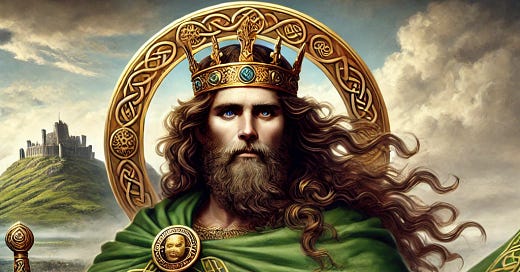Brian Boru is one of Ireland’s most legendary historical figures—celebrated as the king who united the island and drove out the Vikings. His name is forever linked to the famous Battle of Clontarf in 1014, a battle often misrepresented as a great Irish victory over foreign invaders. But who was Brian Boru really? Was he a unifying ruler, a ruthless warlord, or something in between?
In this post, we will explore the true story of Brian Boru, from his rise to power to his dramatic death, separating fact from fiction to understand the man behind the legend.
The Rise of Brian Boru
Early Life in the Kingdom of Munster
Brian Boru was born around 941 AD in Thomond, modern-day County Clare, into the powerful Dál gCais clan. His father, Cennétig mac Lorcáin, was the King of Thomond, a relatively minor kingdom in Munster. At the time, Ireland was divided into multiple competing kingdoms, each ruled by local kings who constantly fought for dominance.
One of the greatest powers in Ireland at the time was the Kingdom of Munster, ruled by Brian’s older brother, Mathgamain mac Cennétig. Mathgamain waged war against the Viking settlements in Limerick and other Gaelic rivals. However, he was captured and executed in 976 by rival Irish forces, leaving Brian to take his place as leader of the Dál gCais.
Avenging His Brother: The Battle Against the Vikings and Munster Rivals
Brian proved to be a shrewd and ambitious leader. He continued his brother’s campaign against the Vikings of Limerick, crushing them at the Battle of Sulcoit in 977. Instead of simply driving the Vikings out, Brian took a different approach—he absorbed them into his army. Many Norse warriors became mercenaries in Brian’s forces, helping him expand his influence.
With the Vikings weakened, Brian turned his attention to the rest of Munster. He successfully overthrew the Eóganacht dynasty, the long-standing rulers of the province, and became King of Munster around 978. His next goal? The High Kingship of Ireland.
The Road to High King of Ireland
At the time, Ireland’s High King (Ard Rí na hÉireann) was Máel Sechnaill mac Domnaill, of the powerful Uí Néill dynasty. Traditionally, the High King ruled from the Hill of Tara, but his authority was often challenged by regional kings.
Brian Boru spent the next two decades consolidating his power. He forged alliances, waged wars, and forced rival kings into submission. In 1002, after a series of victories, he forced Máel Sechnaill to submit to him, making Brian the High King of Ireland—the first from outside the Uí Néill dynasty in centuries.
However, his rule was not universally accepted. Many Irish kings, particularly in Leinster and Ulster, resented his growing power. These tensions would ultimately lead to the famous Battle of Clontarf in 1014.
The Battle of Clontarf: What Really Happened?
The Rebellion Against Brian Boru
By 1013, a powerful coalition had formed against Brian, led by Máel Mórda mac Murchada, King of Leinster, and Sigtrygg Silkbeard, the Norse King of Dublin. Sigtrygg sought help from the Viking rulers of the Orkney Islands and the Isle of Man, bringing Norse warriors to fight alongside the Irish rebels.
On April 23, 1014, Brian Boru’s forces met the rebel army at Clontarf, near modern-day Dublin. The battle was one of the bloodiest in Irish history, lasting from sunrise until evening.
Victory at a Cost
Brian’s forces ultimately won the battle. The Viking and Leinster forces were crushed, and many of their leaders—including Jarl Sigurd of Orkney and Máel Mórda—were killed. However, Brian himself did not survive the day.
Despite being in his seventies and too old to fight, Brian was present in his war tent, praying as the battle raged. As the Viking forces retreated, a small group of Norse warriors stumbled upon his tent. According to legend, a Viking named Brodar discovered Brian and killed him with an axe before being hunted down and executed by Brian’s men.
Though Brian Boru won the battle, his death led to immediate political instability. His dream of a unified Ireland died with him.
Legacy of Brian Boru
Myth vs. Reality
The Battle of Clontarf is often misrepresented as an Irish vs. Viking conflict, but the reality was more complicated. Many of Brian’s own forces included Norse warriors, and many Irish kings fought alongside the Vikings against him. The battle was more about internal Irish power struggles than a war against foreign invaders.
Still, Brian Boru’s reign is remembered as the closest Ireland came to unity before the English invasion centuries later. His descendants, the O’Briens, remained powerful in Irish history, and his story became legendary in Gaelic folklore.
Did Brian Boru Drive the Vikings Out of Ireland?
Another common myth is that Brian’s victory at Clontarf ended Viking influence in Ireland. In reality, Viking settlements like Dublin, Waterford, and Limerick remained important trade hubs, though their military power had weakened. The real decline of Viking influence came later with the rise of Norman rule in the 12th century.
Brian Boru in Irish Culture
Brian Boru remains one of Ireland’s most famous historical figures. His name appears in songs, books, and even Irish whiskey brands. The Brian Boru Harp, which now serves as the symbol of Ireland, is said to be linked to him (though it actually dates to the 14th century).
Conclusion: A Warrior, a King, a Legend
Brian Boru was a brilliant strategist, a fierce warrior, and a ruler with a vision of a unified Ireland. Though his dream of permanent unity never came to pass, his legacy endured as a symbol of Irish resistance and pride.
His story, a mix of fact and legend, has captivated generations and remains an integral part of Ireland’s rich history. Whether seen as a hero or a ruthless conqueror, Brian Boru’s impact on Ireland is undeniable.




